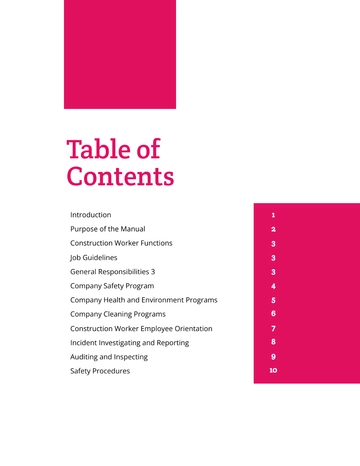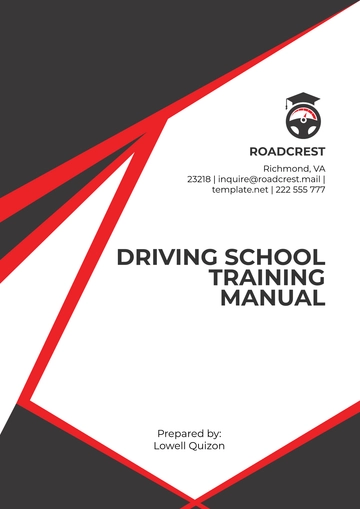Free Agriculture Sales Training Manual

I. Introduction to Agriculture Sales
Welcome to [Your Company Name]'s Agriculture Sales Training Manual. This guide is designed to equip you with the knowledge and skills needed for a successful career in agriculture sales. The agricultural sector offers diverse opportunities, and understanding the essentials of sales can significantly boost your performance.
Agriculture sales involve promoting and selling products such as seeds, fertilizers, and farming equipment. This manual will cover all necessary aspects, ensuring that you are well-prepared to meet the industry's demands. If you require assistance at any stage, do not hesitate to contact us at [Your Company Number] or [Your Company Email].
II. Understanding Agricultural Products
Welcome to the “Understanding Agricultural Products” section of our Sales Training Manual. This section is designed to equip you with the essential knowledge needed to excel in agricultural product sales. A deep understanding of our products' features, benefits, and applications is key to building trust with customers and delivering effective solutions.
In the following table, you will find a comprehensive overview of the core components of product knowledge. It covers everything from technical specifications and benefits to safety precautions, regulatory compliance, and ongoing education. Use this as a resource to deepen your expertise and enhance your sales techniques.
Knowledge Area | Description | Key Points | How to Learn |
|---|---|---|---|
Product Specifications | Technical details and attributes of agricultural products. | Features, Technical Specs, Lifespan & Maintenance | Datasheets, Manuals, Technical Support |
Product Benefits and Applications | Advantages of products and how they can be used effectively. | Benefits, Use Cases | Brochures, Case Studies, Field Trials |
Safety Precautions and Regulations | Measures for safe use and legal compliance of agricultural products. | Safety Measures, Legal Compliance | SDS, Training Programs, Regulations |
Product Updates and Continuing Education | Keeping up-to-date with new products and educational opportunities. | New Products, Ongoing Training | Newsletters, Trade Shows, Online Courses |
Building Trust with Customers | Strategies for establishing credibility and providing customer support. | Communication, Expertise, Support | Professional Interaction, Follow-up |
III. Market Research and Analysis
Effective sales strategies are built on a foundation of accurate market research and analysis. Understanding market dynamics, customer preferences, and the competitive landscape is crucial for identifying opportunities and crafting targeted sales approaches. This section provides a structured approach to market research, offering insights and tools to help you stay ahead in the agricultural industry.
1. Understanding Market Dynamics
To develop successful sales strategies, you must grasp the overall market environment. This includes:
Market Trends: Track changes in the agricultural sector such as new technologies, crop trends, and evolving consumer demands.
Economic Factors: Understand economic indicators like commodity prices, trade policies, and inflation that impact market conditions.
2. Identifying Customer Preferences
Knowing what drives customer decisions helps tailor your sales efforts. Focus on:
Customer Needs: Identify what customers are looking for in agricultural products, such as higher yields or eco-friendly options.
Buying Behavior: Analyze how customers make purchasing decisions, including factors like price sensitivity and brand loyalty.
3. Analyzing the Competitive Landscape
A thorough analysis of your competitors helps you position your products effectively:
Competitor Strategies: Research what competitors are offering, their pricing, and their marketing tactics.
Market Positioning: Determine your unique selling points compared to competitors to differentiate your products.
4. Utilizing Market Research Tools
Leverage tools and methods to gather and analyze market data:
Data Collection Tools: Use surveys, focus groups, and market analysis software.
Data Analysis Techniques: Employ statistical methods, SWOT analysis (Strengths, Weaknesses, Opportunities, Threats), and trend analysis.
5. Staying Informed about Industry News
Keep up with industry advancements and news to adapt your strategies:
Industry News: Follow agricultural news, join professional organizations, and attend trade shows.
Networking: Engage with industry professionals and join relevant forums.
IV. Sales Strategies and Techniques
Effective sales strategies and techniques are essential for achieving success in agricultural sales. Implementing these strategies will help you meet your sales targets, foster strong customer relationships, and stay competitive in the market.
Developing a Comprehensive Sales Plan
A well-thought-out sales plan forms the backbone of your sales efforts. Start by setting clear, achievable goals for your sales activities. Establish both short-term and long-term targets that are Specific, Measurable, Achievable, Relevant, and Time-bound (SMART). Outline the stages of the sales process, from lead generation to closing deals, and identify key metrics to track your performance. Metrics such as conversion rates, average deal size, and customer acquisition costs will help you measure success and adjust strategies as needed. Regularly review your sales plan to ensure that you remain on track to meet your objectives.
Applying Effective Sales Techniques
To effectively engage with customers, adopt proven sales techniques. Begin with consultative selling, which focuses on understanding the customer's needs rather than just pushing products. This approach requires active listening and asking open-ended questions to uncover the customer’s specific requirements and challenges. Solution selling is another key technique where you present your product as a solution to the customer's problems or goals. Craft a compelling value proposition that highlights the unique benefits of your product compared to competitors. Demonstrating how your product solves problems and adds value will help persuade customers and drive sales.
Building and Maintaining Strong Customer Relationships
Long-term success in sales depends on your ability to build and maintain strong relationships with customers. Engage with your customers through regular follow-ups and personalized communication to show that you value their business. Providing ongoing support, such as advice on product use or sharing relevant industry information, helps to foster trust and loyalty. When facing objections, approach them with empathy and provide thoughtful solutions to address concerns. Effective customer relationship management (CRM) tools can help you organize interactions and ensure you stay connected with customers.
Leveraging Marketing Tools to Support Sales Efforts
Marketing tools play a crucial role in supporting your sales efforts. Digital marketing strategies, including social media campaigns, email marketing, and Search Engine Optimization (SEO), can help you reach new customers and promote your products. Additionally, content marketing through blog posts, videos, and infographics can showcase your expertise and engage potential clients. Develop a marketing plan that aligns with your sales goals and use analytics tools to measure the effectiveness of your marketing initiatives. Regularly review and adjust your marketing strategies based on performance data.
Striving for Continuous Improvement
To ensure ongoing success in agricultural sales, commit to continuous improvement. Participate in sales training workshops and courses to enhance your skills and stay updated on best practices. Collect feedback from customers to gain insights into your sales approach and identify areas for improvement. By embracing a mindset of growth and learning, you can refine your techniques and adapt to changes in the industry.
V. Customer Relationship Management
Building and maintaining strong relationships with customers is crucial for success in agriculture sales. Effective Customer Relationship Management (CRM) practices not only help you manage interactions but also foster customer satisfaction and loyalty. A well-implemented CRM system can be a valuable tool in your sales strategy.
Utilizing a CRM System
A CRM system helps you keep detailed records of customer interactions, including contact information, past communications, and purchase history. Use the system to manage leads, track follow-ups, and schedule reminders for future actions. For example, you can set up automated emails for follow-up after a sales meeting or schedule reminders for contract renewals. Regularly update customer information and review the data to identify trends and opportunities for further engagement.
Choose a CRM platform that suits your needs, such as Salesforce, HubSpot, or Zoho CRM. Train yourself on how to use the features effectively and integrate the system into your daily routine.
Listening Actively to Customers
Active listening involves giving full attention to the customer, acknowledging their concerns, and responding thoughtfully. This practice helps you gain insights into their needs and preferences, allowing you to offer tailored solutions. For instance, if a customer expresses concerns about a product’s performance, listen carefully and ask follow-up questions to understand their experience fully.
Practice techniques such as:
Paraphrasing the customer’s statements
Asking clarifying questions
Summarizing their concerns to ensure you address their issues effectively.
Addressing Customer Concerns Promptly
Responding quickly and effectively to customer concerns demonstrates that you value their business and are committed to resolving issues. Ensure that you have a clear process for handling complaints and queries. For example, set up a system for escalating unresolved issues to higher management if needed.
Establish standard procedures for handling common issues, and train your team to follow these protocols. Use CRM features to log issues and track their resolution status.
Providing Excellent After-Sales Support
Excellent after-sales support involves offering ongoing assistance and resources to customers after they make a purchase. This support can include product maintenance tips, answering follow-up questions, and providing additional resources. For example, you might offer a follow-up consultation or send out newsletters with tips on maximizing product use.
Develop a plan for after-sales support that includes:
Regular follow-ups
Educational content
A clear process for addressing post-purchase issues
Personalizing Communication and Follow-Ups
Tailor your interactions with customers based on their preferences and history. Personalization can range from addressing customers by their names to customizing your communication based on their past interactions. For instance, reference previous conversations or offer special promotions related to their previous purchases.
Use CRM data to personalize your communication, such as acknowledging significant milestones or offering tailored recommendations.
VI. Negotiation Skills
Negotiation is a critical skill for achieving successful sales outcomes in the agricultural industry. Effective negotiation techniques help you reach agreements that benefit both you and your customers. By mastering negotiation skills, you can close deals more effectively, handle objections, and build stronger relationships.
1. Preparing for Negotiations
Before entering any negotiation, it is essential to be well-prepared. Start by understanding the needs, interests, and priorities of both parties. Research your customer's background, including their previous purchases, preferences, and budget constraints. Prepare a list of your own objectives and determine your minimum acceptable terms. Develop a clear understanding of your product’s value proposition and how it meets the customer’s needs. This preparation helps you anticipate potential objections and plan effective counteroffers.
Conduct thorough research on the customer, review market conditions, and define your goals and limits. Use negotiation planning tools or templates to organize your strategy.
2. Building Rapport and Establishing Trust
Establishing a connection with your customer can make negotiations smoother and more productive. Begin the conversation with friendly greetings and engage in small talk to break the ice. Show genuine interest in the customer’s needs and concerns, and demonstrate empathy by acknowledging their points of view. Building rapport helps to create a cooperative atmosphere, making it easier to reach mutually beneficial agreements.
Use active listening techniques, express understanding, and find common ground with the customer. Personalize your interactions to show you are invested in their success.
3. Employing Effective Negotiation Techniques
Use various negotiation techniques to achieve favorable outcomes. Begin with a collaborative approach, where you work together to find solutions that satisfy both parties. Employing techniques such as BATNA (Best Alternative to a Negotiated Agreement) helps you understand your options if negotiations fail. Additionally, use principled negotiation strategies, focusing on interests rather than positions, to find win-win solutions. Techniques like anchoring (starting with an initial offer) and concessions (making strategic compromises) are also effective.
Learn techniques like BATNA and principled negotiation through workshops or online courses. Practice anchoring and concession strategies in role-playing scenarios.
4. Handling Objections and Reaching Agreements
During negotiations, objections are inevitable. Address objections calmly and constructively. Listen to the customer’s concerns without interrupting, and respond with well-thought-out solutions. Reiterate the benefits of your product and provide evidence to support your claims. When reaching agreements, be clear about the terms and confirm that both parties understand and accept the final deal.
Develop strategies for common objections and practice responses through role-playing exercises. Ensure all terms are documented and confirmed at the end of negotiations.
5. Closing the Deal
Successful closure involves summarizing the agreed terms and moving towards finalizing the contract. Confirm that all parties are satisfied with the terms and address any last-minute concerns. Use closing techniques such as the assumptive close (assuming the customer will agree) or the summary close (summarizing the benefits before asking for a commitment). Ensure all agreements are documented and follow up to finalize the sale.
Practice closing techniques through simulations and ensure you have a checklist for finalizing agreements and contracts.
VIII. Legal and Ethical Considerations
In agriculture sales, understanding and adhering to legal and ethical standards is crucial for maintaining professional integrity and avoiding legal issues.
Legal Compliance: Involves following federal, state, and local regulations, such as ensuring all product claims are truthful, adhering to safety standards, and respecting contract laws. Stay updated on legal requirements through resources like legal advisors or industry associations.
Ethical Sales Practices: Focus on honesty, transparency, and fairness in all interactions. Avoid misleading customers, provide accurate product information, and respect customer privacy. Adopting a code of ethics and practicing fair negotiation strategies help build trust and ensure long-term success.
Regularly review legal regulations, attend compliance training, and adopt a personal and organizational code of ethics.
VII. Use of Technology in Sales
In today’s agriculture sales environment, leveraging technology is essential for success. Technology enhances efficiency, streamlines processes, and provides valuable insights that drive better sales outcomes. From Customer Relationship Management (CRM) systems to data analytics, modern tools can transform how you interact with customers, track sales performance, and manage administrative tasks.
Understanding and using these technologies effectively will not only improve your productivity but also provide a competitive advantage in the agriculture industry. This section explores various technological tools and strategies that can optimize your sales efforts.
Here are some key Legal and Ethical Considerations to keep in mind while integrating technology into your sales practices:
CRM Systems
CRM systems are essential tools for managing customer relationships and sales processes. They help track interactions, manage leads, and analyze customer data to improve sales strategies. Learn to use CRM features like contact management, sales tracking, and reporting to keep your sales efforts organized and effective.
Marketing Automation
Marketing automation tools streamline marketing efforts through automated email campaigns, social media management, and customer segmentation. These tools can increase your reach, enhance customer engagement, and generate leads more efficiently.
Data Analytics
Data analytics tools provide insights into sales performance, market trends, and customer behavior. By analyzing this data, you can make informed decisions, identify opportunities, and adjust your sales strategies.
Sales Performance Tracking
Tracking sales performance helps evaluate effectiveness and identify areas for improvement. Use technology to set goals, monitor progress, and analyze results to ensure you meet your sales targets.
Administrative Task Automation
Automating administrative tasks reduces manual work and improves efficiency. Tools for automating tasks like order processing, invoicing, and reporting can free up time for more strategic activities.
IX. Performance Evaluation and Improvement
Regular performance evaluation is essential to identify areas for improvement and set goals for professional growth. Use Key Performance Indicators (KPIs) to measure your sales performance against targets. Analyze your successes and identify any challenges you faced.
Use this information to develop an action plan for continuous improvement. Seek feedback from your supervisors and colleagues, and participate in training programs to enhance your skills. Regularly reviewing and refining your approach will help you achieve better sales results.
X. Resources and Support
[Your Company Name] is committed to providing you with the resources and support needed to succeed in agriculture sales. Access our comprehensive library of training materials, product information, and sales tools through our internal portal. Attend workshops and seminars to enhance your knowledge and skills.
If you need assistance or have any questions, do not hesitate to reach out to our support team at [Your Company Number] or [Your Company Email]. We value your feedback and encourage you to share your thoughts on how we can improve our training programs. Your success is our priority, and we are here to support you every step of the way.
- 100% Customizable, free editor
- Access 1 Million+ Templates, photo’s & graphics
- Download or share as a template
- Click and replace photos, graphics, text, backgrounds
- Resize, crop, AI write & more
- Access advanced editor
Enhance your team's skills with the Agriculture Sales Training Manual Template from Template.net. This fully customizable and editable template is designed for comprehensive sales training. Easily editable in our Ai Editor Tool, you can tailor it to fit your specific training needs, ensuring effective and professional sales development.





























